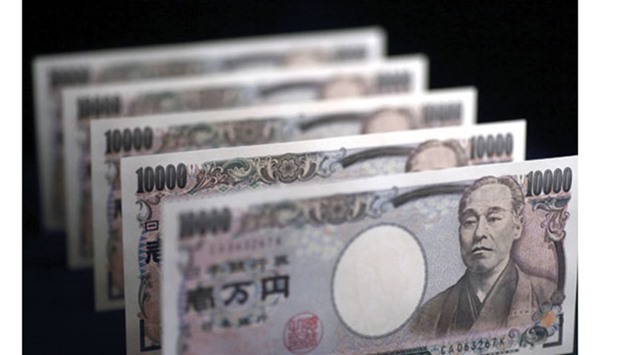JPMorgan Chase & Co is making two contrarian calls: First that the yen will strengthen towards 100 per dollar and second that such a rally won’t destroy the world’s third-largest economy.
Tohru Sasaki, Tokyo-based head of Japan markets research, sees a gain to 110 next year from about 121 now, the most bullish among around 60 forecasts compiled by Bloomberg. While Sasaki sees the equilibrium exchange rate at “below 100,” he doesn’t see that as spelling the end for the recovery in corporate profits.
“What investors like to hear is that the yen is weak and stocks are up - but if everyone’s constantly betting that way, at some point they’re going to get burned,” Sasaki, who worked at the Bank of Japan for more than a decade before joining JPMorgan in 2003, said in a December 18 interview. “It’s possible that equity prices keep going up forever, because everyone is working to maximise their returns. But in the forex market, it will never happen - there’s an up and down.”
JPMorgan’s view clashes with the consensus among analysts for the yen to slide to 125 per dollar next year, which would complete a five-year decline of 38%. A weakening exchange rate under Prime Minister Shinzo Abe has underpinned a doubling of stock prices as profits swelled to an all-time high. While selling the currency and buying equities became so prevalent that analysts dubbed it the Abenomics trade, Sasaki says investors are overly obsessed with the exchange rate.
Sasaki’s projection is predicated on a rebound in Japan’s current account surplus, which reached its widest level since 2008 in March. In the first 10 months, the surfeit in the broadest measure of trade amounted to ¥13.3tn, more than five times the ¥2.6tn registered in all of 2014.
The yen has also become “significantly” undervalued after the BoJ’s trade-weighted index slid to an eight-year low in June, according to Sasaki. A Bloomberg gauge of consumer purchasing power parity shows the yen is 39% undervalued compared to the dollar, the most among major currencies.
It’s not the first time JPMorgan has gone against the grain. Sasaki’s contrarian call for the currency to rally in the first half of 2014 proved prescient. In the second half of the same year, he escalated his forecast for yen weakness following a surprise BoJ easing, predicting 120 per dollar for September 30 of this year. It closed that day at 119.88 and was recently at 120.92.
While he’s now in the minority among yen forecasters, the ranks of bulls are swelling. Seventeen analysts now see gains to at least 120 next year, versus 13 on November 30.
Many bears are counting on BoJ Governor Haruhiko Kuroda to drive weakness, after two rounds of stimulus since April 2013 helped push the currency to a 13-year low of 125.86 per dollar in June. Analysts are almost evenly split on the chances of an expansion of the quantitative and qualitative easing program. JPMorgan sees additional QQE late in 2016 having no lasting impact on the yen.
JPMorgan predicts Japan’s economy will expand 1.1% in 2016, matching the median estimate from more than 50 forecasts compiled by Bloomberg. That’s after growth ground to a halt in 2014 following a sales-tax increase that April.
Brokerages are more optimistic on Japanese stocks, even as they expect earnings growth to decline for the first time since 2012. The Nikkei 225 Stock Average will surge 18% to 22,250 by the end of 2016, according forecasts compiled by Bloomberg.
Yen declines are slowing, with this year’s 1% loss just a fraction of the at-least 11% tumbles each year from 2012. Hedge funds are also closing bets on depreciation, slashing so-called net shorts by the most since August in the week to December 15, Commodity Futures Trading Commission data show.
Sasaki expects an unwinding of bearish positions among domestic investors too, driving the yen to 115 by March 31 next year. They include the ¥8.5tn in bets against the yen, ¥10tn in overseas holdings of investment trusts and the 50tn yen in retained earnings at Japanese Corps that could see increased hedging, JPMorgan estimates.
“Different from past episodes of the yen carry trade, this time the major sellers of the yen are Japanese,” he said, referring to a strategy where investors borrow yen cheaply to invest in higher-yielding nations. “Japanese will need to unwind those positions eventually. The yen is no longer the ideal funding currency.”
Funding carry trades in yen lost money against every major currency in the second half except the New Zealand dollar.
Neither the BoJ nor politicians want additional weakness, as wage gains have failed to keep pace with surging food prices, squeezing consumers, according to Sasaki.
The yen drop also spurred a record number of bankruptcies among small- and medium- sized businesses dependent on imported materials. JPMorgan sees its benefits as exaggerated.
“The economy is not driven only by the foreign-exchange rate,” he said. “If the growth momentum is strong, I think the Japanese economy can overcome it.”

Japanese u00a510,000 notes are arranged for a photograph in Tokyo. JPMorgan’s view clashes with the consensus among analysts for the yen to slide to 125 per dollar next year, which would complete a five-year decline of 38%.


